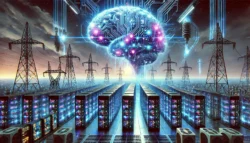
The headlines tell one story: OpenAI, Meta, Google, and Anthropic are in an arms race to build the most powerful AI models. Every new release—from DeepSeek’s open-source model to the latest GPT update—is treated like AI’s next great leap into its destiny. The implication is clear: AI’s future belongs to whoever builds the best model.
That’s the wrong way to look at it.
The companies developing AI models aren’t alone in defining its impact. The real players in AI supporting mass adoption aren’t OpenAI or Meta—they are the hyperscalers, data center operators, and energy providers making AI possible for an ever-growing consumer base. Without them, AI isn’t a trillion-dollar industry. It’s just code sitting on a server, waiting for power, compute, and cooling that don’t exist. Infrastructure, not algorithms, will determine how AI reaches its potential.
AI’s Growth, and Infrastructure’s Struggle to Keep Up
The assumption that AI will keep expanding infinitely is detached from reality. AI adoption is accelerating, but it’s running up against a simple limitation: we don’t have the power, data centers, or cooling capacity to support it at the scale the industry expects.
This isn’t speculation, it’s already happening. AI workloads are fundamentally different from traditional cloud computing. The compute intensity is orders of magnitude higher, requiring specialized hardware, high-density data centers, and cooling systems that push the limits of efficiency.
Companies and governments aren’t just running one AI model, they’re running thousands. Military defense, financial services, logistics, manufacturing—every sector is training and deploying AI models customized for their specific needs. This creates AI sprawl, where models aren’t centralized, but fragmented across industries, each requiring massive compute and infrastructure investments.
And unlike traditional enterprise software, AI isn’t just expensive to develop—it’s expensive to run. The infrastructure required to keep AI models operational at scale is growing exponentially. Every new deployment adds pressure to an already strained system.
The Most Underappreciated Technology in AI
Data centers are the real backbone of the AI industry. Every query, every training cycle, every inference depends on data centers having the power, cooling, and compute to handle it.
Data centers have always been critical to modern technology, but AI amplifies this exponentially. A single large-scale AI deployment can consume as much electricity as a mid-sized city. The energy consumption and cooling requirements of AI-specific data centers far exceed what traditional cloud infrastructure was designed to handle.
Companies are already running into limitations:
- Data center locations are now dictated by power availability.
- Hyperscalers aren’t just building near internet backbones anymore—they’re going where they can secure stable energy supplies.
- Cooling innovations are becoming critical. Liquid cooling,
- immersion cooling, and AI-driven energy efficiency systems aren’t just nice-to-haves—they are the only way data centers can keep up with demand.
- The cost of AI infrastructure is becoming a differentiator.
- Companies that figure out how to scale AI cost-effectively—without blowing out their energy budgets—will dominate the next phase of AI adoption.
There’s a reason hyperscalers like AWS, Microsoft, and Google are investing tens of billions into AI-ready infrastructure—because without it, AI doesn’t scale.
The AI Superpowers of the Future
AI is already a national security issue, and governments aren’t sitting on the sidelines. The largest AI investments today aren’t only coming from consumer AI products—they’re coming from defense budgets, intelligence agencies, and national-scale infrastructure projects.
Military applications alone will require tens of thousands of private, closed AI models, each needing secure, isolated compute environments. AI is being built for everything from missile defense to supply chain logistics to threat detection. And these models won’t be open-source, freely available systems; they’ll be locked down, highly specialized, and dependent on massive compute power.
Governments are securing long-term AI energy sources the same way they’ve historically secured oil and rare earth minerals. The reason is simple: AI at scale requires energy and infrastructure at scale.
At the same time, hyperscalers are positioning themselves as the landlords of AI. Companies like AWS, Google Cloud, and Microsoft Azure aren’t just cloud providers anymore—they are gatekeepers of the infrastructure that determines who can scale AI and who can’t.
This is why companies training AI models are also investing in their own infrastructure and power generation. OpenAI, Anthropic, and Meta all rely on cloud hyperscalers today—but they are also moving toward building self-sustaining AI clusters to ensure they aren’t bottlenecked by third-party infrastructure. The long-term winners in AI won’t just be the best model developers, they’ll be the ones who can afford to build, operate, and sustain the massive infrastructure AI requires to truly change the game.
The post The Real Power in AI is Power appeared first on Unite.AI.


